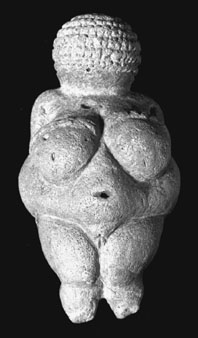

 | Page 578 |  |
Germany as a political unity—from a historical perspective—is a relatively recent and unstable structure. The German Empire was founded in 1871, and the last division of Germany ended in 1989. Therefore it makes no sense to limit the discussion of “German” prehistoric archaeology to the area within the actual political boundaries of the Federal Republic of Germany. Rather, it is necessary to include in this survey all the regions of central Europe where German is spoken today, including areas in austria and switzerland. Despite all the political conflicts the regions connected by the German language during the last two centuries shared a common culture. This is especially true in the academic field, where intense contacts often existed regardless of political boundaries.

The Venus of Willendorf
(Francis G. Mayer/Corbis)
Research undertaken in Austria and Switzerland contributed much to the development of prehistoric archaeology, as the publications of the Viennese Anthropological Society and the Antiquarian Society of Zurich clearly show. Sites such as Austria’s Willendorf, with its famous Upper Paleolithic Venus statue, or Hallstatt, with its large Iron Age cemetery—which gave its name to a whole period—have become landmarks in the development of our knowledge of European prehistory. This is also true for the famous lake-dwellings in northeastern Switzerland, which were first discovered in the winter of 1853–1854. In Germany itself the Neanderthal skeleton found in 1856 in a Neolithic cemetery at Rössen, the rich chieftains’ graves from the Bronze and early Iron Ages at Leubingen, Helmsdorf, Seddin, and Kleinaspergle, the deposits of golden objects at Vettersfelde (today Witaszkowo, poland) and Eberswalde, the Roman limes (armed frontiers) and Slavic hill-forts from the eastern part of the country have all dominated our knowledge and understanding of the distant past in the early phases of the development of prehistoric archaeology.
In the twentieth century large-scale excavations of prehistoric settlements have greatly added to this knowledge. These sites include the early-Neolithic village of Köln-Lindenthal, the late–Bronze Age wetland settlement at Buchau in the Federsee area, the early–Iron Age hill-fort “Heuneburg,” the Celtic oppidum (fortified town) at Manching, and the settlements of the period from the Roman to the Viking ages in the coastal areas of northern Germany. Along with these settlements many cemeteries and graves have also been excavated, such as the famous Iron Age princes’ graves (Fürstengräber) found in 1978 near Hochdorf and in 1994 at the foot of the Glauberg hill-fort.
The cultural and intellectual life of the German-speaking areas, unlike that of other strongly centralized polities, was not concentrated in one capital but dispersed over a number of regional centers. This federal structure is mirrored in the large number of local and regional museums and associations devoted to the study of antiquities. On the one hand, this situation provides a varied and fascinating picture; on the other hand, it is sometimes difficult to see the connections between what happened in different parts of central Europe at certain points of time. This situation
 |  |